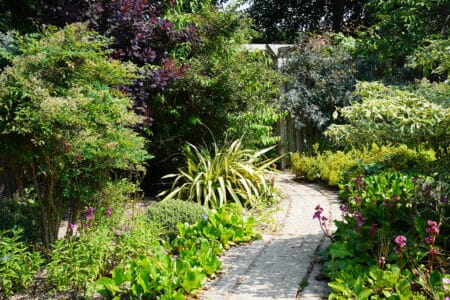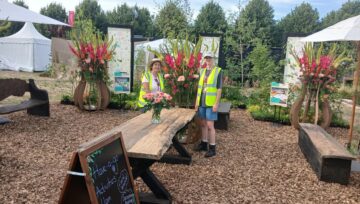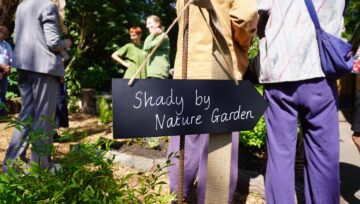Celebrating 25 Years of the Low Allergen Garden
2021 marks the 25th anniversary of the Low Allergen Garden at Capel Manor Gardens which forms part of our Enfield Campus.
The Garden was originally designed by Lucy Huntingdon and exhibited at the RHS Chelsea Flower Show in 1996 where it won a Silver-Gilt Medal.
Supported by Asthma UK, the Garden returned to Capel Manor Gardens where it is now a permanent display. The aim of this design is to help all those who suffer from asthma and/or hay fever to get more enjoyment from their gardens.
The Garden had a planting redesign in 2008 by Janet Godley but still adheres to allergy guidelines, these include: the use of insect pollinated plants rather than wind pollinated ones, the avoidance of heavy scented plants, no grass, the use of gravel as a mulch, and groundcover plants to suppress weeds.
Why a low allergen garden?
More than five million people in the UK have asthma, which, like hay fever, can be set off by a reaction to many different allergens – including pollens and mould spores – that originate from the garden. Grass pollen is the most frequent cause of hay fever. In the UK 30% of people are allergic to grass pollen.
Despite ongoing research, no cure has yet been found for asthma. However, we now know much more about what triggers asthma and hay fever, and the benefits to be gained from trying to avoid some of these allergens.
The Low Allergen Garden at Capel Manor Gardens demonstrates a few simple measures that can be taken in gardens to lessen exposure to allergens and thereby help reduce the severity of asthma and hay fever symptoms.
Where to start?
The most important thing is to learn which plants to select. Choose plants that are insect pollinated. The pollen from wind-pollinated plants is light and floats around in the air and can trigger hay fever and asthma symptoms. The pollen from insect-pollinated plants is heavy and too large to inhale.
Avoid heavily scented plants. These can be replaced with gently fragrant herbs such as mint or rosemary. Plants in the daisy (Asteraceae) family, the pink (Caryophyllaceae) family and plants with downy leaves can also cause an allergic reaction.
Why this design for the Low Allergen Garden?
The Garden has been designed to make a special feature of hard landscaping and gravel in order to avoid the use of grass and hedges. There are three focal points: the fountain with gentle flowing water, a bench to provide a space to sit and enjoy the garden, and a mosaic to amuse.
When should I garden?
It is best to try and get your garden in order in the early spring when the pollen count is low. In the summer, on hot, still days, the pollen grains are released and do not blow away, and it may be best to remain inside on these days.
Gardening in the morning or early afternoon is best, as pollen counts are highest during the late afternoon and evening. Wearing sunglasses while gardening can help to reduce pollen contact with the eyes and associated symptoms.
Check the pollen forecast and remember, it is important to consult your doctor or nurse regularly for reviews of your asthma and hay fever treatments. Remember, always have your reliever handy when gardening.
Key design features to consider:
Grass – Consider replacing the lawn with attractive paving. If this is not possible, remember an electric cylinder mower is best. Shut all windows before mowing.
Mulch – Use gravel as a non-allergic mulch.
Water – Think about a water feature. Gentle running water is soothing, although fountains may make pollen and mould spores airborne. Pools are not suitable where there are children. Pool plants do not cause allergies.
Compost – Remove all rotting vegetation and compost to avoid moulds growing and releasing their spores into the air.
Ground cover – Plant low allergen ground cover plants to cover exposed planting areas and stifle weeds.
Plants – Remove any plants that are not low-allergen plants. Replace with suitable plants from the low-allergen plant list.
Hedges – Replace hedges with a painted fence or any kind of wall. Hedges harbour dust, pollen and mould spores, which are released in strong winds and when the hedge is cut.
Our Enfield Campus is set over 30 acres of landscaped Gardens, it is a beautiful place to visit for relaxation and inspiration with over 40 gardens to enjoy throughout the year. To find out more visit www.capelmanorgardens.co.uk.




